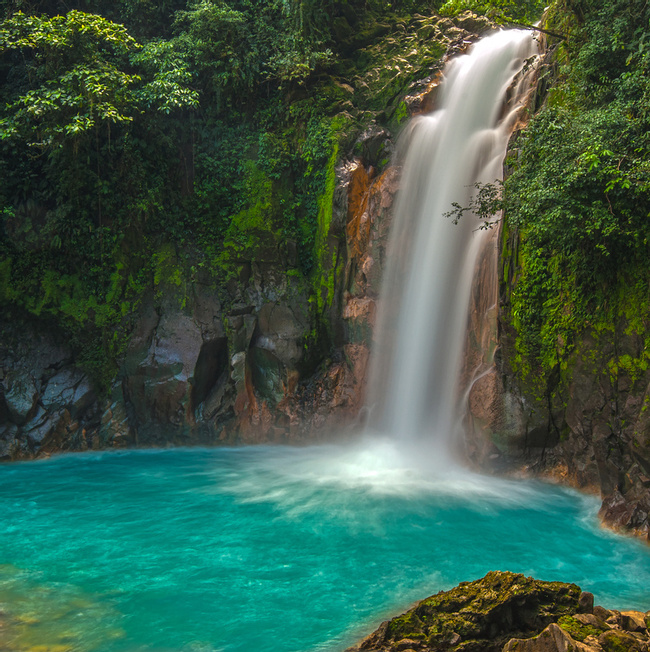- Travel Guides
Costa Rica Weather
Costa Rica is a tropical country with two distinct seasons—dry and wet. However, within these seasons and in different parts of the country there is lots of variation. The Guanacaste region is the driest, while the highlands are generally colder and misty. The Caribbean coast has unpredictable (and usually wetter) weather, and the Pacific coast can be hot year-round.

The reason for this diversity is the close proximity of the Pacific Ocean and Caribbean Sea, as well the mountain ranges that separate these two bodies of water. Travel from one side of Costa Rica to another, or from the coast to the mountains, and you’ll be in an entirely different microclimate. In general, higher areas are cooler and have more rain.
There are 12 hours of sunlight each day. The sun typically rises around 5:45 am and sets around 5:45 pm. The average temperature in Costa Rica is 76°F.
Video: Weather in Costa Rica

The dry season lasts from December through March or April. Referred to as verano (summer) by locals, this season is marked by days that are typically rain-free. That said, rain can fall during this season, particularly along the Caribbean coast. The length of the dry season varies by region. In Guanacaste, for example, the dry season may last several weeks longer than in other parts of the country.
The rainy season—also called the green season—lasts from May to early December. Costa Ricans refer to this period of the year as invierno, or winter. During this season, the mornings are usually sunny, with rainfall occurring in the afternoon. There are fewer travelers (aside from June and July, which correspond to North American and European summers), but most activities are still offered. A common approach taken by travelers is to be active during the morning and then relax with a book or a cup of coffee during the afternoon rain.
When to Go
The best time of year to visit Costa Rica depends in part on what you would like to do. As already mentioned, most activities can be enjoyed year-round. December and January, however, are two of the nicest months—the countryside is still green from the rain, the rivers have a moderate to high flow (which is good for rafting), and the weather is usually sunny.
Turtles arrive along the Caribbean coast from February to October. The high season for green turtles is in August and September; for leatherbacks, it is in April and May. The best time of year to see the resplendent quetzal is from November to April. Migratory birds can be spotted during the spring and fall.
In some places, surf breaks are consistent year-round. However, the Pacific coast sees larger swells and bigger waves during the rainy season, especially in September and October. The Caribbean coast has the best surfing from November through May.
Fishing is good year-round, but there are some times of year that are better for certain species. Sailfish are best fished between November and May along the Pacific coast. Along the Caribbean coast, snook are best from September through November, while tarpon are at peak numbers between January and May.
Making Your Dream Vacation A Reality
Getting to Costa Rica is easy enough. Most international travelers will arrive by air at one of Costa Rica's two (2) international airports. Gaining entry into the country is typically neither a long nor invovled process—provided that you are prepared to meet all entry requirements.
Did you bring everything you need? In addition to factoring in Costa Rica's micro-climates, don't forget to consider they type of vacation experience you are hoping to have. Adventureres will want to read this article, while those seeking a relaxing experience will find their packing tips here.
Regional Characteristics
The following is a rundown of what you can expect when visiting the various regions of Costa Rica.
• Guanacaste (Liberia, Tamarindo, Playa del Coco) – these lowlands are hot and have dry forests
• Nicoya Peninsula (Mal País, Montezuma, Samara) – these lowlands are hot and have dry forests.
• Central Pacific (Manuel Antonio, Jacó, Puntarenas) – these lowlands are hot, humid, and have rainforests.
• South Pacific (Osa Peninsula, Dominical, Corcovado) – these lowlands are hot, humid, and have rainforests.
• Northern Lowlands (Arenal, Sarapiquí Valley) – these lowlands are hot but cool at night, and have rainforests.
• Central Highlands (Monteverde, San Ramón, Tilarán) – these highlands have moderate temperatures and are cool at night. They have cloud forests.
• Central Valley (San José, Grecia, Santa Ana) – these highlands have a mild climate and are cool at night.
• South Central (San Gerado de Dota, La Amistad International Park) – this area has a mild climate.
• Caribbean Coast (Puerto Viejo de Limón, Tortuguero) – these lowlands are hot, humid, and have rainforests.
We believe travel is more than ticking destinations off a list – it’s about discovering new places deeply, feeling connected wherever you go, and knowing you have a trusted team behind you every step of the way.



